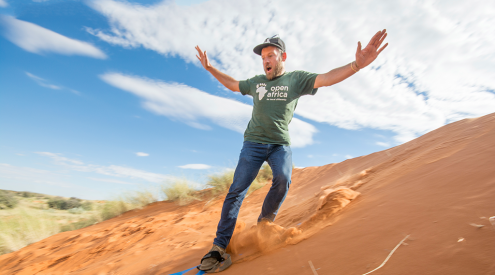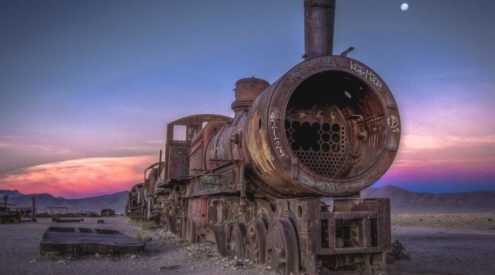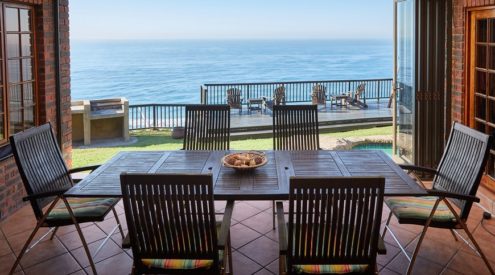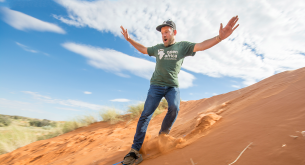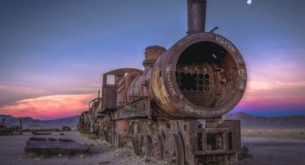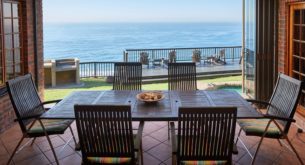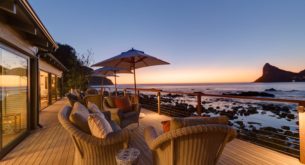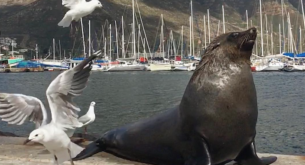From a distance, it looks like any shimmering body of water, but up close Gariep Dam is an engineering marvel packed with history, nature and geographical significance.
Words by Ondela Mlandu. Photographs by Melanie van Zyl.

Ariel view of the Gariep Dam at sunset. Image by Melanie van Zyl
We’re leaving the Free State and heading towards the Eastern Cape. We could even get as far as the Northern Cape if the dam was overflowing,’ Wikus Wiese chuckles as he steers the boat across the water. The surface is so still it appears viscous. Wiese, who runs boat tours, tells me that the seemingly infinite stretch of water around us is only a fraction of the dam. With a surface area of 374 square kilometres when full, Gariep is the largest dam in South Africa and supplies water to most of the southern Free State and Eastern Cape.
As we approach the 88-metre-high dam wall, I feel like a speck at the foot of a looming, almost futuristic structure. When the dam was finished in 1972, costs amounted to about R300 000. Today, a construction like this would carry a far heftier price tag of around R3,5 billion. In January 2011, due to good rains in the catchment area, the dam filled up to 125 per cent and overflowed by four metres for three months. That mass of water could have filled five Olympic-sized swimming pools every second. As we chug back towards the shore, I gaze wistfully at the water lapping high up on the banks and wish I could take some of it home to parched Cape Town.
A hush has settled over the Gariep, A Forever Resort as I wander towards my car. Maybe everyone is having an afternoon nap? It makes sense that watersport enthusiasts and nature lovers flock here to escape city life. The 165-kilometre route that meanders around the dam and through the Gariep Dam Nature Reserve is a drawcard for those wanting to see wildlife such as springbok and black wildebeest. The thing about this area is that initially it seems to offer very little besides flat brown plains and hills and a few scattered settlements. However, journey along the route, pause to look carefully and you’ll be rewarded with small and big wonders secreted in the scrub. Plus, you’ll pass through three provinces in a matter of minutes.

Anglers can cast a line for yellowfish, tilapia and mudfish, among others. Image by Melanie van Zyl
My drive starts in the Free State part of the reserve, which was formed by merging former stock farms. It’s rumoured that many of the buildings on these farms vanished beneath the water, never to be seen again. Before heading out I drop in for lunch at Rustiq Pub and Grill, next to the Quest petrol station, where most of the cars parked outside have their windows open. I lock and check all my car doors before entering – city habits are hard to break.
I meet Nic du Toit, the local magistrate and chairman of the Chamber of Commerce who has been in Gariep for 20 years. His son, Hentie, owns the pub. Hentie convinces me to have a Klippies and Coke. I agree, without much hesitation. ‘This is one of the safest places in South Africa,’ says Nic, as he takes a sip of his draught beer. ‘The Gariep is a “secret” place that’s already known.’ A group of Australians walks into the restaurant and their heads immediately turn to the rugby game on TV; there’s also a young couple who have stopped for lunch. ‘Some of the men who built the dam still live in the area. There’s a long chain of family trees, and people talk about their fathers and grandfathers having been part of the construction process,’ says Nic. He loves the familiarity and intimacy of the Gariep region, but hopes it remains treasured, not ‘overrun like Hartbeespoort Dam’. ‘There’s hardly a single sport that you can’t find here. We have it all,’ he says, pointing out of the window at three hang gliders in the sky.

The dam wall consists of roughly 1,73 million cubic metres of concrete. Image by Melanie van Zyl
The road to the dam wall is tarred and accessible to all vehicles. Gert Isaks, who has been a guide at the site for more than 16 years, gives a safety briefing to me and three doctors here on a day trip from Bloemfontein. When Gert tells us we’ll be walking 13 kilometres, I activate the pedometer app on my phone. At this rate, I’m bound for platinum status. Once inside the dam wall, we come upon myriad tunnels. The water makes slapping noises against the concrete and I realise I’m holding my breath as we head down the narrow, dimly lit passages. I bat away thoughts of leaks and cracks and a wall of water, focusing on my echoing footsteps.
After two hours, we huddle in a control room and Gert demonstrates how, with just a push of a button, the sluices open and a column of water gushes out. Droplets of water splash my face and the noise is thunderous. Watching the intense pressure and pace at which it’s released makes me marvel at how engineers are able to construct something so big, so precise and so strong. Gert closes the sluices and I want to applaud. That night, I sink into bed early, my head swirling with images of water.

The cute red-roofed chalets of the Gariep, A Forever Resort create the impression of a storybook village; Pellissier Museum House in Bethulie is one of the oldest settler buildings still standing in the Free State. Image by Melanie van Zyl
The following morning, I’m awake at 6.30am and determined to see the sun rise over the dam I sit in my car near the wall, watching the fluffy reflections of clouds on the calm surface of the water. Within a few minutes, the sun slowly makes its theatrical entrance, infusing the water with shades of blue and brown. It’s peaceful here, far away from the city, watching nature gently awaken. I start the car and head towards the Oviston tunnel, not far from Oviston Nature Reserve in the Eastern Cape. I’d read about the tunnel while researching the trip and I’m curious to see it – apparently it can easily accommodate a double decker bus and stretches for 73 kilometres, all underground. I think about what it must have been like to dig a tunnel in 1966; how technology has changed and how manual it must have been. I also think of how important water is – and has always been – for humankind. This tunnel is used to supply water to the Fish River, which in turn passes through Cradock and heads to Kirkwood and the citrus valleys of the Eastern Cape. It’s an essential artery in the country’s water-distribution network.
After reaching Oviston Nature Reserve, my little car rebels. No matter how much I coax her, she refuses to tackle the rocks and holes in the road. So I head to the farming town of Bethulie, which is rumoured to have changed its name at least 34 times. On my way, I drive over the beautiful, arched Hennie Steyn Bridge (formerly known as the Bethulie Bridge) which, at more than a kilometre long, is the longest bridge in the country. Below, the mighty Orange River churns its way towards Gariep Dam. A drive through the town takes me into Voortrekker Street, where I stop to explore the Pellissier House Museum. Built in 1834, it was originally the home of Reverend Jean-Pierre Pellissier, a French missionary. The house is now a museum run by locals and provides visitors with a glimpse of living conditions in the 1800s, including information on a nearby concentration camp set up during the Anglo-Boer War.

Hennie Steyn Bridge is the longest road-and-rail structure in the country and connects the Eastern Cape with the Free State. Image by Melanie van Zyl
I wake early again the next morning. This time the dam lies mirror-like outside my hotel window. As I sip my coffee and gaze at the view, I feel as though Gariep was meant to test me: my off-road driving skills, my navigation abilities when phone reception was intermittent, and connecting the dots between water and towns, nature and people, and Klippies and Coke. There is a charged energy in this area,perhaps due to the intersection of humankind and nature – the way the dam wall looms over the surrounding bush like a colossal monument. I will de nitely come back, with a group of friends for company – and a sturdier car. And I’d probably avoid winter, when night-time temperatures can drop to below freezing, although it would be a pity to miss the setting winter sun, which wraps the wall in a golden hue.
Gariep’s powerhouse
Besides being the largest water reservoir in the country, Gariep Dam also serves as a power station – a hydroelectric station, to be precise. Just as coal-fired plants use steam to generate electricity, hydro ones use the force of running water to turn a turbine, which then spins a metal shaft in an electric generator, which produces electricity. Eskom’s Gariep Hydroelectric Power Station has four turbines that can produce up to 360 megawatts of constant electricity. That’s enough to power about 240 000 average homes.

Gariep Dam at sunset is a good place to reflect on the day’s activIties. Image by Melanie van Zyl
Plan your trip
Getting there
Fly to Bloemfontein. Drive south-west on the N1 to the Gariep Dam area – about 200km. Flights from Cape Town to Bloemfontein with Mango are from R2 708 and from Joburg, with South African Airways, from R1 998 return. travelstart.co.za
Need to know
The laid-back pace in the Gariep area means establishments have a slow start. The average opening time for most shops and restaurants is 9am (later on a Sunday). If you plan on fishing or boating, bring your own gear.
Stay here
Adamsview comprises luxury and standard self-catering units. All have air conditioners, DStv and a patio and garden area to
soak up the sun. Luxury units (one has a spa bath facing the dam) from R650 per person sharing, standard units from R450 per person sharing. 0826223366
De Stijl Gariep Hotel has a restaurant with magical views of the dam. There are 43 newly furnished rooms, all with the standard amenities. Pets are welcome, if they are knee high or smaller – a sleeping basket is provided. From R1 120 per person sharing. 0517540060
Gariep Dam Caravan Park is right on the edge of the dam. Campsites with electricity cost R250 per person (maximum five people), those without are R150 per person. Rates include the reserve entry fee. 051750026

The Gariep Dam. Image by Melanie van Zyl
Do this
Connect with nature on a 25km game- and bird-viewing drive in the Gariep Dam Nature Reserve. Wildlife includes brown hyenas, black wildebeest, red hartebeest and bat-eared foxes. Birds to spot include blue cranes, martial eagles, fish eagles and Cape teals. Entrance R70 per car (maximum five passengers, R15 per extra person). 0517540026
Go fishing in the Gariep Dam in the reserve, strictly catch and release. The large-mouth yellowfish here are listed as a vulnerable species. Angling costs R40 per person. 0517540026
Walk inside the Gariep Dam wall and learn about hydroelectric power. The 13km walk is not recommended if you have claustrophobia. Wear comfortable shoes and take something warm. Free, but it’s essential to book. 0828888386
Get out on the water with Gariep Boat Cruises from the Forever Resort. Take your own food and drinks. R120 per person for an hour. 0517540190
Snap a picture on the Hennie Steyn Bridge near Bethulie. Built in 1879, it spans 1.2km over the Orange River between the Eastern Cape and Free State.
Go back in history at the Pellissier House Museum in Bethulie, which has exhibits of life in this region during the 1800s. Free entry. 0517622525
Hike in Oviston Nature Reserve near Venterstad (you’ll need a high-clearance vehicle to get here). Recommended by locals, it encompasses 16 000 hectares, and has well-marked walking trails. There is also a guided overnight hike. Entry R20 adults, R10 kids. 0872857390
Visit the Norvalspont Concentration Camp. Some 366 Boer women and children died in captivity here during the Anglo-Boer War (1899 to 1902). Open daily; free entry.
This article first appeared in the May 2018 issue of Getaway magazine.
Our May 2018 issue features the ultimate Karoo road trip, magical Qolora on the Wild Coast, a Lesotho shootout (wild versus luxury); hiking, boating and fishing on the Gariep Dam, we explore Scotland’s Isle of Skye, plus lots more.

You may also like

